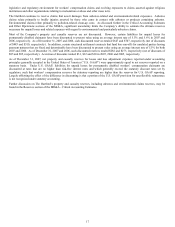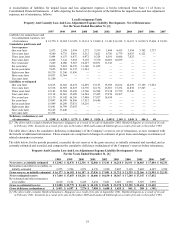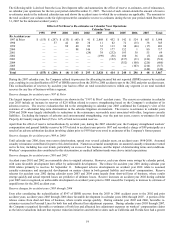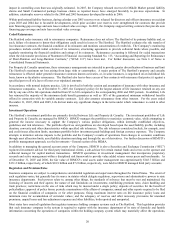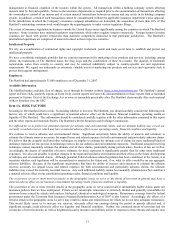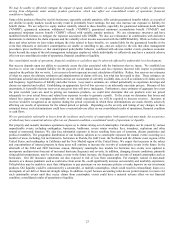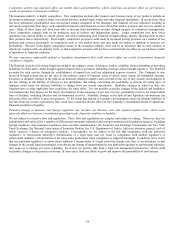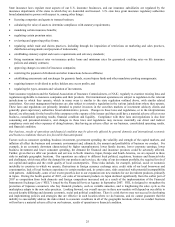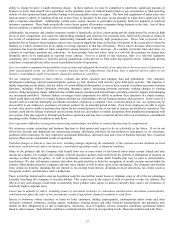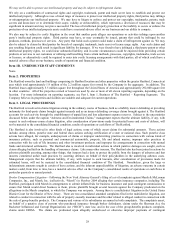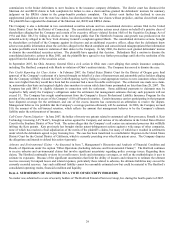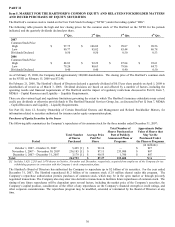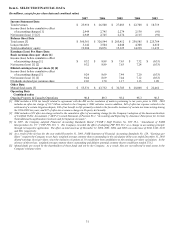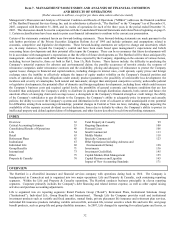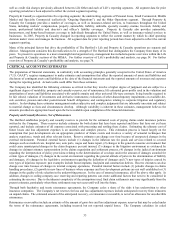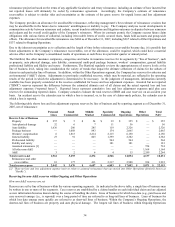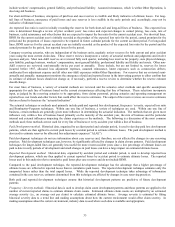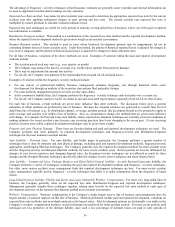The Hartford 2007 Annual Report Download - page 26
Download and view the complete annual report
Please find page 26 of the 2007 The Hartford annual report below. You can navigate through the pages in the report by either clicking on the pages listed below, or by using the keyword search tool below to find specific information within the annual report.26
We may experience difficulty in marketing and distributing products through our current and future distribution channels.
We distribute our annuity, life and certain property and casualty insurance products through a variety of distribution channels, including
brokers, independent agents, broker-dealers, banks, wholesalers, affinity partners, our own internal sales force and other third-party
organizations. In some areas of our business, we generate a significant portion of our business through individual third-party
arrangements. For example, we generated approximately 69% of our personal lines earned premium in 2007 under an exclusive
licensing arrangement with AARP that continues until January 1, 2020. We periodically negotiate provisions and renewals of these
relationships, and there can be no assurance that such terms will remain acceptable to us or such third parties. An interruption in our
continuing relationship with certain of these third parties could materially affect our ability to market our products.
Our business, results of operations, financial condition or liquidity may be adversely affected by the emergence of unexpected and
unintended claim and coverage issues.
As industry practices and legal, judicial, social and other environmental conditions change, unexpected and unintended issues related to
claims and coverage may emerge. These issues may either extend coverage beyond our underwriting intent or increase the frequency
or severity of claims. In some instances, these changes may not become apparent until some time after we have issued insurance
contracts that are affected by the changes. As a result, the full extent of liability under our insurance contracts may not be known for
many years after a contract is issued, and this liability may have a material adverse effect on our business, results of operations,
financial condition or liquidity at the time it becomes known.
We may experience a downgrade in our financial strength or credit ratings, which may make our products less attractive, increase our
cost of capital and inhibit our ability to refinance our debt, which would have an adverse effect on our business, consolidated operating
results, financial condition and liquidity.
Financial strength and credit ratings, including commercial paper ratings, have become an increasingly important factor in establishing
the competitive position of insurance companies. Rating agencies assign ratings based upon several factors. While most of the factors
relate to the rated company, some of the factors relate to the views of the rating agency, general economic conditions, and
circumstances outside the rated company’ s control. In addition, rating agencies may employ different models and formulas to assess
the financial strength of a rated company, and from time to time rating agencies have, in their discretion, altered these models. Changes
to the models, general economic conditions, or circumstances outside our control could impact a rating agency’ s judgment of its rating
and the rating it assigns us. We cannot predict what actions rating agencies may take, or what actions we may be required to take in
response to the actions of rating agencies, which may adversely affect us. Our financial strength ratings, which are intended to measure
our ability to meet policyholder obligations, are an important factor affecting public confidence in most of our products and, as a result,
our competitiveness. A downgrade, or an announced potential downgrade in the rating of our financial strength or of one of our
principal insurance subsidiaries could affect our competitive position in the insurance industry and make it more difficult for us to
market our products, as potential customers may select companies with higher financial strength ratings. The interest rates we pay on
our borrowings are largely dependent on our credit ratings. A downgrade of our credit ratings, or an announced potential downgrade,
could affect our ability to raise additional debt with terms and conditions similar to our current debt, and accordingly, likely increase
our cost of capital. In addition, a downgrade of our credit ratings could make it more difficult to raise capital to refinance any maturing
debt obligations, to support business growth at our insurance subsidiaries and to maintain or improve the current financial strength
ratings of our principal insurance subsidiaries described above. As a result, it is possible that any, or a combination of all, of these
factors may have a material adverse effect on our business, consolidated operating results, financial condition and liquidity.
Limits on the ability of our insurance subsidiaries to pay dividends to us may adversely affect our liquidity.
The Hartford Financial Services Group, Inc. is a holding company with no significant operations. Our principal asset is the stock of our
insurance subsidiaries. State insurance regulatory authorities limit the payment of dividends by insurance subsidiaries. In addition,
competitive pressures generally require certain of our insurance subsidiaries to maintain financial strength ratings. These restrictions
and other regulatory requirements affect the ability of our insurance subsidiaries to make dividend payments. Limits on the ability of
the insurance subsidiaries to pay dividends could adversely affect our liquidity, including our ability to pay dividends to shareholders
and service our debt.
As a property and casualty insurer, the premium rates we are able to charge and the profits we are able to obtain are affected by the
actions of state insurance departments that regulate our business, the cyclical nature of the business in which we compete and our
ability to adequately price the risks we underwrite, which may have a material adverse effect on our consolidated results of operations,
financial condition or cash flows.
Pricing adequacy depends on a number of factors, including the ability to obtain regulatory approval for rate changes, proper evaluation
of underwriting risks, the ability to project future loss cost frequency and severity based on historical loss experience adjusted for
known trends, our response to rate actions taken by competitors, and expectations about regulatory and legal developments and expense
levels. We seek to price our property and casualty insurance policies such that insurance premiums and future net investment income
earned on premiums received will provide for an acceptable profit in excess of underwriting expenses and the cost of paying claims.
State insurance departments that regulate us often propose premium rate changes for the benefit of the consumer at the expense of the
insurer and may not allow us to reach targeted levels of profitability. In addition to regulating rates, certain states have enacted laws
that require a property and casualty insurer conducting business in that state to participate in assigned risk plans, reinsurance facilities,
joint underwriting associations and other residual market plans, or to offer coverage to all consumers and often restrict an insurer’ s



